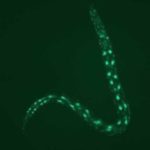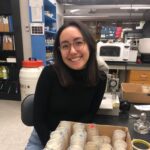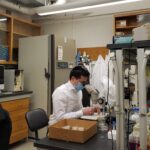
Dr. Cathy Savage-Dunn
Professor
Ph.D., Columbia University
Office: NSB D-330 – Tel: (718) 997-3440
Laboratory: NSB D-349 – Tel: (718) 997-3403
E-mail: Cathy.SavageDunn@qc.cuny.edu
Lab News | Research | People | Publications
Follow us on Twitter @CSwormlab or Instagram @CSwormlab
Mission Statement: To make meaningful contributions to the understanding of cell signaling while developing and imparting critical thinking and problem solving skills.

Research:
Cell-cell signaling is critical to the development and health of multicellular organisms. When cells fail to respond properly to external signals, cells can die prematurely or proliferate inappropriately, leading to diseases such as cancer.
We are interested in understanding how cell signaling regulates animal development. We focus on the TGFβ family of cell signals: a large and evolutionarily conserved class of secreted growth factors. We study TGFβ-related cell signaling using the model organism C. elegans. The nematode (roundworm) C. elegans is an attractive model for the study of cell signaling because of its well-characterized development and cell lineage, as well as the power to apply genetic and molecular biological tools to study signaling pathways in this organism.
Two TGFβ-related signaling pathways have been characterized in C. elegans, the DBL-1 pathway and the DAF-7 pathway. We focus primarily on the DBL-1 pathway, which regulates multiple aspects of development and homeostasis, including body size, reproductive aging, innate immunity, olfactory learning, male sensory organ development, and mesodermal patterning (Savage et al., 1996; Gumienny and Savage-Dunn 2013 and references therein). The components of this pathway and how they interact are highly conserved among species, so that the mechanisms we identify are relevant to the function of TGFβ pathways in vertebrates, including humans. Significantly, the vertebrate homologs of DBL-1 pathway components play a role in the development of cancer, skeletal abnormalities, immune responses, and fat tissue development.
Body size control. Body size mutants in the DBL-1 pathway have reduced body size (small phenotype). Although body, organ, and cell sizes are all precisely regulated during animal development, the mechanisms for this control are only beginning to be understood. We have addressed the mechanism of reduced body size in C. elegans DBL-1 pathway mutants. These mutants have a defect in postembryonic but not embryonic growth. Furthermore, the defect in body size is not due to a reduction in cell number, but to reduced cell size. Finally, we have shown that the signaling components function in the epidermis (known in C. elegans as hypodermis) to regulate body size (Wang et al., 2002). The epidermis is composed primarily of a single large multinucleated epithelial cell that surrounds the animal and secretes the cuticle. We find that the DBL-1 pathway regulates body size by altering the expression of collagens that are incorporated into the cuticle (Liang et al., 2007; unpublished data).
Fat storage. A recent direction in our lab is the investigation of a new role for the DBL-1 pathway in fat storage. Mutants in the pathway have changes in the expression of enzymes required for fat synthesis and storage (Liang et al., 2007). We have used staining techniques to show that these mutants also store significantly less fat than wild type under normal growth conditions. We seek to identify the molecular pathways underlying this defect.
Another gene identified in the genetic screen was ADT-2, which encodes a secreted protease of the ADAMTS family. We showed that ADT-2 is necessary for normal cuticle collagen organization and for normal levels of DBL-1 pathway activation (Fernando et al., 2011).
People

PhD students:
- Emma Ciccarelli (eciccarelli@gradcenter.cuny.edu)
- Kat Yamamoto (kyamamoto@gradcenter.cuny.edu)

Undergraduate students:
- Moshe Bendelstein
- Hannah Reich
Lab alumni:
- Jun Liang Rice (Assoc Prof, Borough of Manhattan Community College)
- Marie McGovern (Asst Prof, Kingsborough Community College)
- Rafal Tokarz (Associate Research Scientist, Columbia University)
- Jianjun Wang (Postdoc, Thomas Jefferson University)
- Thilini Fernando (Scientist, Kite Pharma)
- Edlira Yzeiraj (Medical Fellow, Albert Einstein, Montefiore)
- Jianghua Yin (Technology Associate, Morgan Stanley)
- Sheng Xiong (Postdoc, NYU Langone Medical Center)
- Michael Meade (Orthopedic Surgery Resident, Northwell Health)
- Uday Madaan (Medical Science Liaison, Bioventus)
- James Clark (Postdoc, Mt. Sinai School of Medicine)
- Shahrear Ahmed
- Muhammad Hasan (CUNY PhD student)
- Peter Kayastha
Selected Publications:
Clark, J.F., E.J. Ciccarelli, P. Kayastha, G. Ranepura, K.Y. Yamamoto, M.S. Hasan, U. Madaan, A. Melendez, C. Savage-Dunn. 2021. BMP pathway regulation of insulin signaling components promotes lipid storage in Caenorhabditis elegans. PLoS Genet, 17:e1009836.
Goodman, M.B., C. Savage-Dunn. 2021. Reciprocal interactions between transforming growth factor beta signaling and collagens: Insights from Caenorhabditis elegans. Dev Dynamics.
Madaan, U.*, L. Faure*, A. Chowdhury, S. Ahmed, E.J. Ciccarelli, T.L. Gumienny, C. Savage-Dunn. 2020. Feedback regulation of BMP signaling by Caenorhabditis elegans cuticle collagens. Mol Biol Cell, 31:825-832. *authors contributed equally
Savage-Dunn C., R.J. Gleason, J. Liu, R.W. Padgett. 2019. Mutagenesis and Imaging Studies of BMP Signaling Mechanisms in C. elegans. In: Rogers M. (eds) Bone Morphogenetic Proteins. Methods in Molecular Biology, vol 1891.
Madaan, U., E. Yzeiraj, M. Meade, J.F. Clark, C.A. Rushlow and C. Savage-Dunn. 2018. BMP signaling determines body size via transcriptional regulation of collagen genes in Caenorhabditis elegans. Genetics, 210:1355-1367.
Clark, J.F., and C. Savage-Dunn. 2018. Delta-9 Fatty Acid Desaturase Mutants Display Increased Body Size. microPublication Biology.
Clark, J.F., M. Meade, G. Ranepura, D.H. Hall and C. Savage-Dunn. 2018. Caenorhabditis elegans DBL-1/BMP regulates lipid accumulation via interaction with insulin signaling. G3 8:343-351. https://doi.org/10.1534/g3.117.300416
Liang, J., Y. Shaulov, C. Savage-Dunn, S. Boissinot and T. Hoque. 2017. Chloride intracellular channel proteins respond to heat stress in Caenorhabditis elegans. PLoS ONE 12(9): e0184308.
Savage-Dunn, C., and R.W. Padgett. 2017. The TGF-β Family in Caenorhabditis elegans. Cold Spring Harbor Perspectives in Biology. PDF
Yin, J., U. Madaan, A. Park, N. Aftab and C. Savage-Dunn. 2015. Multiple cis elements and GATA factors regulate a cuticle collagen gene in Caenorhabditis elegans. genesis, 53:278-284.
Gumienny, T.L., and C. Savage-Dunn. 2013. TGF-β signaling in C. elegans. WormBook, ed. The C. elegans Research Community, doi/10.1895/wormbook.1.22.2, http://www.wormbook.org.
Fernando, T., S. Flibotte, S. Xiong, J. Yin, E. Yzeiraj, D.G. Moerman, A. Meléndez and C. Savage-Dunn. 2011. C. elegans ADAMTS ADT-2 regulates body size by modulating TGFβ signaling and cuticle collagen organization. Dev. Biol., 352:92-103.
Savage-Dunn, C., L. Yu, K. Gill, M. Awan, T. Fernando. 2011. Nonstringent tissue-source requirements for BMP ligand expression in regulation of body size in Caenorhabditis elegans. Genetics Research, 93:427-432.
Yin, J., L. Yu and C. Savage-Dunn. 2010. Alternative trans-splicing of Caenorhabditis elegans sma-9/schnurri generates a short transcript that provides tissue-specific function in BMP signaling. BMC Molecular Biology, 11:46.
McGovern, M., L. Yu, M. Kosinski, D. Greenstein and C. Savage-Dunn. 2007. A Role for Sperm in Regulation of Egg-Laying in the Nematode C. elegans. BMC Developmental Biology, 7:41.
Liang, J., L. Yu, J. Yin, and C. Savage-Dunn. 2007. Transcriptional Repressor and Activator Activities of SMA-9 Contribute Differentially to BMP-Related Signaling Outputs. Developmental Biology,305:714-725.
Liang, J., R. Lints, M.L. Foehr, R. Tokarz, L. Yu, S.W. Emmons, J. Liu, and C. Savage-Dunn. 2003. The Caenorhabditis elegans schnurri homolog, sma-9, mediates stage- and cell type-specific responses to dbl-1 BMP-related Signaling. Development, 130:6453-6464.
Savage-Dunn, C., L.L. Maduzia, C.M. Zimmerman, A.F. Roberts, S. Cohen, R. Tokarz and R.W. Padgett. 2003. A Genetic Screen for Small Body Size Mutants in C. elegans Reveals Many TGFβ Pathway Components. genesis 35:239-247.
Wang, J., R. Tokarz and C. Savage-Dunn. 2002. The expression of TGFβ signal transducers in the hypodermis regulates body size in C. elegans. Development 129:4989-4998.
Savage, C., P. Das, A.L. Finelli, S.R. Townsend, C.Y. Sun, S.E. Baird and R.W. Padgett 1996. Caenorhabditis elegans genes sma-2, sma-3, and sma-4 define a conserved family of transforming growth factor β pathway components. Proc. Natl. Acad. Sci. 93:790-794.


